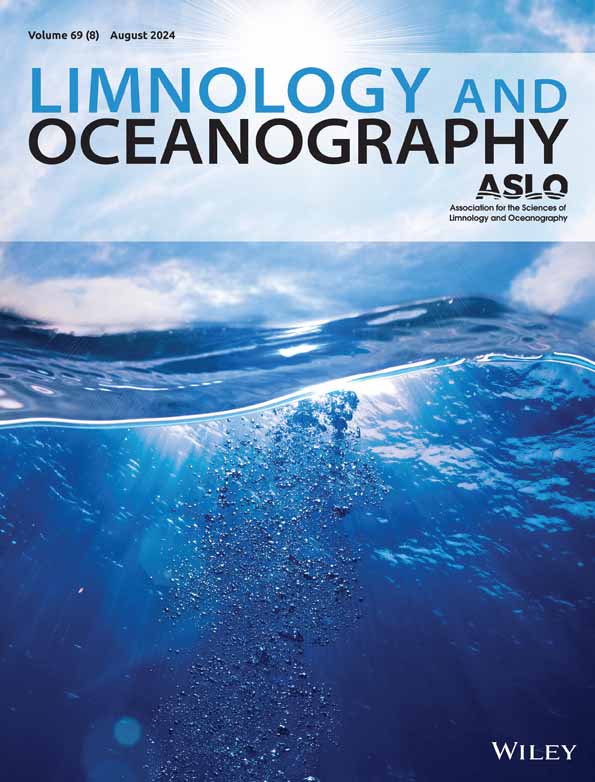在北太平洋东部的初级生产热点地区,不同的浮游植物组合
IF 3.8
1区 地球科学
Q1 LIMNOLOGY
引用次数: 0
摘要
海洋东部边界流生态系统,如加利福尼亚流系统(CCS),涉及生产性中营养化过渡带。CCS显示出高度可变的初级生产(PP),然而驱动变异的因素和潜在的浮游植物群落仍然知之甚少。我们整合了在10次CCS考察中采集的地表水的物理化学和生物数据,跨越13年,并解决了不同浮游植物群落的制度。除了低营养状态(OR)外,沿海地区以外的中营养水域分为中高和中低状态,硝酸盐浓度和PP不同。OR由原绿球藻高光I (HLI)主导,真核浮游植物主要是掠食性混合营养生物。中低和中高浮游植物生物量以真核生物为主。在中低温菌群中,绿单胞菌(Pelagomonas calceolata)占有重要地位,低光照I原绿球藻(Prochlorococcus Low‐Light I, LLI)的地位上升。在中高海拔地区,有大量的裸色红葡萄球菌和IV系聚球菌。Meso‐High表现出最高的PP(38±16 mg C m−3 d−1);p & lt;光合真核生物的生长速率(0.84±0.02 d - 1)高于原绿球藻(0.61±0.01 d - 1)和聚球藻(0.31±0.05 d - 1)。模拟季节性低营养海水入侵中高河段的实验结果显示,藻体的生长速率分别为1.18±0.10 d - 1 (O. lucimarinus)、0.75±0.21 d - 1(原绿球藻LLI)和0.50±0.04 d - 1(聚球藻EPC2)。因此,可变的PP是由不同的浮游植物群落支撑的,它们的动态性质受到特定分类群对不断变化的环境条件或可能从病毒遭遇中短暂释放营养物质的反应速度的影响。未来的工作应该评估这些动态是否在东部边界洋流生态系统和时间变化上是一致的。本文章由计算机程序翻译,如有差异,请以英文原文为准。
Distinct phytoplankton assemblages underlie hotspots of primary production in the eastern North Pacific Ocean
Marine eastern boundary current ecosystems, such as the California Current System (CCS), involve productive, mesotrophic transition zones. The CCS exhibits highly variable primary production (PP), yet factors driving the variability and underlying phytoplankton communities remain poorly understood. We integrated physicochemical and biological data from surface waters sampled during 10 CCS expeditions, spanning 13 yr, and resolved regimes with distinct phytoplankton communities. Additional to an oligotrophic regime (OR), mesotrophic waters beyond the coastal area partitioned into Meso‐High and Meso‐Low regimes, differing in nitrate concentrations and PP. The OR was dominated by Prochlorococcus High‐Light I (HLI), and eukaryotic phytoplankton were largely predatory mixotrophs. Eukaryotes dominated Meso‐Low and Meso‐High phytoplankton biomass. Within the Meso‐Low, Pelagomonas calceolata was important, and Prochlorococcus Low‐Light I (LLI) rose in prominence. In the Meso‐High, the picoprasinophyte Ostreococcus lucimarinus was abundant, and Synechococcus Clade IV was notable. The Meso‐High exhibited the highest PP (38 ± 16 mg C m−3 d−1 ; p < 0.01) and higher growth rates for photosynthetic eukaryotes (0.84 ± 0.02 d−1 ) than for Prochlorococcus (0.61 ± 0.01 d−1 ) and Synechococcus (0.31 ± 0.05 d−1 ). An experiment simulating seasonal oligotrophic seawater intrusion into the Meso‐High resulted in growth rates reaching 1.18 ± 0.10 d−1 (O. lucimarinus ), 0.75 ± 0.21 d−1 (Prochlorococcus LLI), and 0.50 ± 0.04 d−1 (Synechococcus EPC2). Thus, variable PP is underpinned by distinct phytoplankton communities across CCS mesotrophic regimes, and their dynamic nature is influenced by the rapidity with which specific taxa respond to changing environmental conditions or possibly transient nutrient release from viral encounters. Future work should assess whether these dynamics are consistent across eastern boundary current ecosystems and over temporal variations.
求助全文
通过发布文献求助,成功后即可免费获取论文全文。
去求助
来源期刊

Limnology and Oceanography
地学-海洋学
CiteScore
8.80
自引率
6.70%
发文量
254
审稿时长
3 months
期刊介绍:
Limnology and Oceanography (L&O; print ISSN 0024-3590, online ISSN 1939-5590) publishes original articles, including scholarly reviews, about all aspects of limnology and oceanography. The journal''s unifying theme is the understanding of aquatic systems. Submissions are judged on the originality of their data, interpretations, and ideas, and on the degree to which they can be generalized beyond the particular aquatic system examined. Laboratory and modeling studies must demonstrate relevance to field environments; typically this means that they are bolstered by substantial "real-world" data. Few purely theoretical or purely empirical papers are accepted for review.
 求助内容:
求助内容: 应助结果提醒方式:
应助结果提醒方式:


